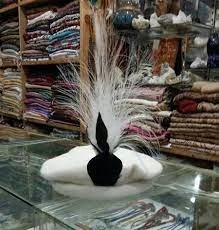Introduction:
Nestled in the breathtaking landscapes of Gilgit-Baltistan, the Gilgiti Cap with Feather stands as a cultural gem, reflecting the rich heritage of the region. This distinctive headgear, adorned with intricate embroidery and a unique feather, is more than just an accessory—it is a symbol of tradition, identity, and the artistic prowess of the local craftsmen. In this exploration, we delve into the captivating story of the Gilgiti Cap, tracing its historical roots, examining its exquisite craftsmanship, and unraveling the cultural significance woven into its very fabric.
Historical Roots:
To understand the significance of the Gilgiti Cap with Feather, we must embark on a journey through time, tracing its historical roots deep into the heart of the Himalayas. The cap's origins are intertwined with the ancient Silk Road, the historic trade routes that connected Gilgit-Baltistan to Central Asia and beyond. As merchants and travelers traversed these routes, they brought with them not only goods but also a vibrant tapestry of cultures.
The Gilgiti Cap emerged as a testament to the region's cosmopolitan identity, blending diverse cultural influences into a unique and recognizable form. Its design, inspired by the confluence of traditions, became a visual representation of the interconnectedness of the people along the Silk Road.
Craftsmanship and Design:
At the core of the Gilgiti Cap's allure is the meticulous craftsmanship that goes into its creation. Skilled artisans, often heirs to centuries-old techniques, dedicate their time and expertise to handcraft each cap, transforming it into a work of art. The cap's visual appeal is heightened by vibrant colors, intricate embroidery, and a distinctive feather, making it a masterpiece that transcends mere utility.
The embroidery on the cap is not arbitrary; rather, it tells a story. Traditional motifs, often inspired by nature and the region's landscapes, are meticulously stitched onto the fabric. These motifs not only contribute to the cap's aesthetic charm but also serve as carriers of cultural narratives, preserving the stories and traditions of Gilgit-Baltistan.
The feather, a crowning glory of the Gilgiti Cap, is more than a decorative element. It holds symbolic significance, representing a connection to nature, spirituality, and the rugged terrain of the region. The choice of feather varies, ranging from the majestic plumage of local birds to other indigenous species, adding an extra layer of uniqueness to each cap.
Cultural Significance:
Beyond its visual appeal and historical roots, the Gilgiti Cap with Feather carries profound cultural significance for the people of Gilgit-Baltistan. It is not merely an accessory; it is a symbol of identity, pride, and a living connection to the region's past.
Wearing the Gilgiti Cap is a tradition passed down through generations. It is often donned during significant cultural events, celebrations, and ceremonies, becoming an integral part of the local attire. The cap serves as a visual marker of one's affiliation with the community, reflecting a deep respect for tradition and a commitment to preserving cultural identity.
Moreover, the Gilgiti Cap acts as a unifying symbol within the diverse communities of Gilgit-Baltistan. In a region where multiple ethnicities and languages coexist, the cap becomes a shared cultural emblem, fostering a sense of unity and mutual understanding.
Preserving Heritage:
In the face of modernization and globalization, the Gilgiti Cap with Feather plays a crucial role in preserving the cultural heritage of Gilgit-Baltistan. As younger generations embrace contemporary lifestyles, there is a growing concern about the potential loss of these cultural treasures.
Efforts are underway to promote and sustain the craftsmanship associated with the Gilgiti Cap. Artisan cooperatives, cultural initiatives, and educational programs are working to ensure that the skills required to create these caps are passed down to future generations. Additionally, there is a growing market for these caps, both within the region and internationally, providing economic opportunities for the skilled artisans.
Conclusion:
As we immerse ourselves in the story of the Gilgiti Cap with Feather, we discover more than just a piece of traditional headgear. We unveil a cultural masterpiece that encapsulates the spirit of Gilgit-Baltistan—a region where history, tradition, and artistic brilliance converge. The cap serves as a bridge between the past and the present, a tangible reminder of the enduring legacy of the Silk Road and the resilience of cultural traditions.
In celebrating the Gilgiti Cap, we pay homage to the skilled artisans who, with their hands and hearts, continue to weave the threads of tradition. This unique headgear not only graces the heads of the locals but also stands as a beacon, inviting the world to appreciate and preserve the diverse cultural heritage of Gilgit-Baltistan—one stitch, one feather at a time.



